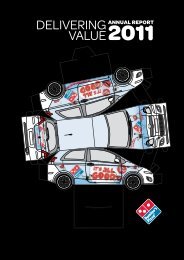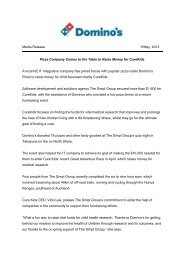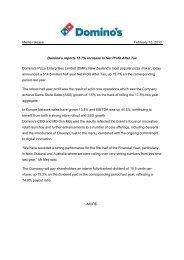2012 Annual Report - Domino's Pizza
2012 Annual Report - Domino's Pizza
2012 Annual Report - Domino's Pizza
Create successful ePaper yourself
Turn your PDF publications into a flip-book with our unique Google optimized e-Paper software.
3.8.5 Dividend and interest revenue<br />
Dividend revenue from investments is<br />
recognised when the shareholder’s right to<br />
receive payment has been established (provided<br />
that it is probable that the economic benefits<br />
will flow to the Consolidated entity and the<br />
amount of revenue can be reliably measured).<br />
Interest revenue is recognised when it is<br />
probable that the economic benefits will flow<br />
to the Consolidated entity and the amount of<br />
revenue can be measured reliably. Interest<br />
revenue is accrued on a time basis, with<br />
reference to the principal outstanding and at<br />
the effective interest rate applicable, which<br />
is the rate that exactly discounts estimated<br />
future cash receipts through the expected<br />
life of the financial asset to that asset’s net<br />
carrying amount on initial recognition.<br />
3.9 Share-based payments<br />
Equity-settled share-based payments to<br />
employees and others providing similar<br />
services are measured at the fair value of<br />
the equity instrument at the grant date. The<br />
fair value is measured by use of a binomial<br />
model. The expected life used in the model<br />
has been adjusted, based on management’s<br />
best estimate, for the effects of nontransferability,<br />
exercise restrictions, and<br />
behavioural considerations. Details regarding the<br />
determination of the fair value of equity-settled<br />
share-based transactions are set out in note 33.<br />
The fair value determined at the grant date<br />
of the equity-settled share-based payments<br />
is expensed on a straight-line basis over the<br />
vesting period, based on the Consolidated<br />
entity’s estimate of equity instruments that<br />
will eventually vest. At each reporting period,<br />
the Consolidated entity revises its estimate of<br />
the number of equity instruments expected<br />
to vest. The impact of the revision of the<br />
original estimates, if any, is recognised in<br />
profit or loss over the remaining vesting<br />
period, with corresponding adjustment to the<br />
equity-settled employee benefits reserve.<br />
The policy described above is applied to<br />
all equity-settled share-based payments<br />
that were granted after 7 November<br />
2002 that vested after 1 January 2005.<br />
No amount has been recognised in the<br />
financial statements in respect of the other<br />
equity-settled share-based payments.<br />
Equity-settled share-based payment<br />
transactions with other parties are measured at<br />
the fair value of the goods and services received,<br />
except where the fair value cannot be estimated<br />
reliably, in which case they are measured at<br />
the fair value of the equity instruments granted,<br />
measured at the date the entity obtains the<br />
goods or the counterparty renders the service.<br />
3.10 Taxation<br />
Income tax expense represents the sum of<br />
the tax currently payable and deferred tax.<br />
3.10.1 Current tax<br />
The tax currently payable is based on taxable<br />
profit for the year. Taxable profit differs from<br />
profit as reported in the consolidated statement<br />
of comprehensive income because of items of<br />
income or expense that are taxable or deductible<br />
in other years and items that are never taxable<br />
or deductible. The Consolidated entity’s<br />
liability for current tax is calculated using tax<br />
rates that have been enacted or substantively<br />
enacted by the end of this reporting period.<br />
3.10.2 Deferred tax<br />
Deferred tax is recognised on temporary<br />
differences between the carrying amounts of<br />
assets and liabilities in the financial statements<br />
and the corresponding tax bases used in the<br />
computation of taxable profit. Deferred tax<br />
liabilities are generally recognised for all taxable<br />
temporary differences. Deferred tax assets<br />
are generally for all deductible temporary<br />
differences to the extent that it is probable<br />
that taxable profits will be available against<br />
which those deductible temporary differences<br />
can be utilised. Such deferred tax assets and<br />
liabilities are not recognised if the temporary<br />
difference arises from goodwill or from the<br />
initial recognition of goodwill (other than in<br />
a business combination) or other assets and<br />
liabilities in a transaction that affects neither<br />
the taxable profit nor the accounting profit.<br />
Deferred tax liabilities are recognised for<br />
taxable temporary differences associated with<br />
investments in subsidiaries and associates and<br />
interests in joint ventures except where the<br />
Consolidated entity is able to control the reversal<br />
of the temporary differences and it is probable<br />
that the temporary differences will not reverse<br />
in the foreseeable future. Deferred tax assets<br />
arising from deductible temporary differences<br />
associated with these investments and interests<br />
are only recognised to the extent that it is<br />
probable that there will be sufficient taxable<br />
profits against which to utilise the benefits<br />
of the temporary differences that they are<br />
expected to reverse in the foreseeable future.<br />
The carrying amount of deferred tax assets<br />
is reviewed at the end of each reporting<br />
period and reduced to the extent that<br />
it is no longer probable that sufficient<br />
taxable profits will be available to allow<br />
all or part of the asset to be recovered.<br />
Deferred tax assets and liabilities are measured<br />
at the tax rates that are expected to apply in<br />
the period in which the liability is settled or the<br />
asset is realised, based on tax rates (and tax<br />
laws) that have been enacted or substantively<br />
enacted by the end of the reporting period.<br />
The measurement of deferred tax liabilities<br />
and assets reflects the tax consequences<br />
that would follow from the manner in which<br />
the Consolidated entity expects, at the end of<br />
the reporting period, to recover or settle the<br />
carrying amount of its assets and liabilities.<br />
Deferred tax assets and liabilities are offset<br />
when there is a legally enforceable right to<br />
set off current tax assets against current tax<br />
liabilities and when they are related to income<br />
taxes levied by the same taxation authority<br />
and the Consolidated entity intends to settle its<br />
current tax assets and liabilities on a net basis.<br />
3.10.3 Current and deferred tax for the period<br />
Current and deferred tax is recognised as an<br />
expense or income in the profit or loss, except<br />
when they relate to items that are recognised<br />
outside the profit or loss (whether in other<br />
comprehensive income or directly in equity),<br />
in which case the tax is also recognised<br />
outside the profit or loss, or where they arise<br />
from the initial accounting for a business<br />
combination. In the case of a business<br />
combination, the tax effect is included in the<br />
accounting for the business combination.<br />
3.10.4 Tax consolidation<br />
The Company and all its wholly-owned<br />
Australian resident entities are part of a tax<br />
consolidated group under Australian taxation<br />
law. Domino’s <strong>Pizza</strong> Enterprises Limited<br />
is the head entity in the tax-consolidated<br />
group. Tax expense/income, deferred tax<br />
liabilities and deferred tax assets arising from<br />
temporary differences of the members of the<br />
tax-consolidated group are recognised in the<br />
separate financial statements of the members of<br />
the tax-consolidated group using the ‘separate<br />
taxpayer within group approach’ by reference to<br />
the carrying amounts in the separate financial<br />
statements of each entity and the tax values<br />
applying under tax consolidation. Current tax<br />
liabilities and assets and deferred tax assets<br />
arising from unused tax losses and relevant tax<br />
credits of the members of the tax-consolidated<br />
group are recognised by the Company (as<br />
head entity in the tax-consolidated group).<br />
The entities in the tax-consolidated group have<br />
not entered into a tax sharing agreement or<br />
tax funding agreement. Income tax liabilities<br />
payable to the tax authorities in respect of the<br />
tax-consolidated group are recognised in the<br />
financial statements of the parent entity.<br />
ANNUAL REPORT <strong>2012</strong> DOMINO’S PIZZA ENTERPRISES LIMITED 37













